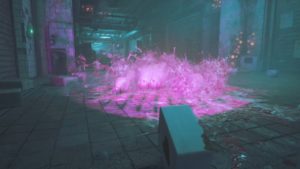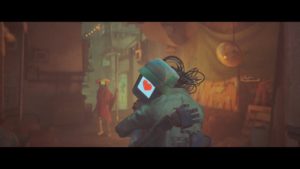Gaming’s ninth generation has been somewhat lackluster. While there have been some major releases that lived up to the hype, very few if any have innovated or pushed a genre forward. On the opposite end of the gaming release spectrum over the last year, smaller, arguable double-A video games found smaller pockets to master and craft shorter, though incredibly profound experiences – “Sifu”, “Trek to Yomi”, and “As Dusk Falls” are just three examples of fantastic, smaller games released in 2022 alone.
In the middle of 2022’s summer season, developer BlueTwelve Studio looked to follow the lead of so many other smaller developmental teams by producing a one-of-a-kind digital experience with “Stray”. The hype of “Stray” came and went though, and, now that a disc version has been released, I decided to finally give this game made for cat enthusiasts a try to see if the waning of continued praise for months on end was because of its short nature or something deeply lacking in the gameplay itself.
Did I Complete “Stray”?
“Stray’s” premise is rather simple: take control of an orange kitty that, through a simple fall, finds itself in the belly of a decayed, neon-tinted world housing sentiment robots who have taken on human traits including working jobs, being enlightened gurus, and creating tools that will protect the helpless from giant tick-like creatures known as “Zurks”. After the first couple of hours, it becomes obvious that “Stray” is rooted in simplicity be it the linear stage design beyond two sections – “The Slums” and “Midtown” – to the general gameplay that will have players jumping onto or across objects, knocking over items, and turning so many things into scratching posts. It’s the addition of a talking drone self-named “B-12” that the emotional crux of “Stray’s” story and, at times, elevated gameplay such as locking turret-sporting flying robots that have the ability to one-shot-kill the furry protagonist behind a gate, becomes present.
The most time consuming aspect of “Stray” comes from its small amount of collectibles that are generally associated with B-12’s history and the gamer understanding the fall of humanity in this city. There is also one frustrating trophy early in the story where a chase sequence from Zurks requires the player to avoid the flood of enemies leaping from every direction that sounds a lot easier than it really is thanks to off-screen attacks and questionable physics. My first playthrough ended in a little over six hours with total collectible and trophy completion other than one requiring an under-two-hours speed run. Another hour and forty-nine minutes would pass with me finishing the game for a second time to gain a platinum trophy.
What Makes “Stray” Unique?
Sporting a harness that allows B-12 to come in and out of sight, the feline main character doesn’t have some type of magical abilities or invulnerability that gives it special traits. In truth, “Stray” presents the protagonist as, simply, a smarter-than-the-average cat that makes calculated jumps across various areas in hopes of helping solve multiple problems including the loss of B-12’s memory. It is through the game’s general traversal and interesting world design that allows for the minimalistic gameplay to shine especially in the more semi-open-world levels. It is during these chapters in “The Slums” and “Midtown” where the player’s puzzle skills are tested the most.
Players will have to figure out connections to create something of a trade route, or steal particular items that will help an NPC infiltrate a facility that, in turn, sneaks in the protagonist. On a first playthrough it is very likely gamers will spend the most time in these chapters due to the level design’s small density and impressive verticality.
Unfortunately, general traversal can be finicky at times when jumping from condense object to condense object like wall-based air conditioner units thanks to the camera’s inability to go through walls. The shake feature, at times, feels a little too ineffective when surrounded and eventually overtaken by Zurks. During particular portions, the player must run past the tick-like Zurks and if unsuccessful, the cat will be overwhelmed unless the player can tap the “Meow” button fast enough to shake the enemies off in time (making it that much more distressing hearing the protagonist constantly cry out while its blood is being drained).
About two-thirds into the story gives B-12 an ultraviolet flashlight that explodes Zurks, though the flashlight quickly overheats. Sadly, there isn’t something like a boss battle with a gigantic Zurk that could’ve added all the gameplay elements together showcasing a chase sequence, platforming, and combat where the player has to manage the flashlight’s heat meter to mix up the norm similar to a short, sequence featuring a speeding cart.
As noted, the only NPCs are the robots enclosed in these varied areas. Though the NPCs are robots, their personalities are incredibly human in nature with their roles in society ranging across multiple human generations from shrine guardians to police officers actually chasing down criminals. It is through these interactions with NPCs like Momo and Clementine that the world itself feels more vibrant. But the story’s heart is rooted in the growing bond between the protagonist and B-12 that culminates in one of the most emotional endings a game has created in quite some time even if the final chapter wraps up too abruptly.
There are a few technical issues beyond the aforementioned platforming problems including frame rate drops oddly during some lesser technical areas compared to the more open areas, physics causing issues with certain items or enemies, and textures flickering or not loading. A slight disappointment is the lack of customization. Considering how “The Slums”, “Midtown”, and “Midtown’s” direct predecessor levels are designed, the ability to do things like dye the cat’s fur or even wear a hat would’ve been interesting and make each player’s cat unique.
“Stray” is, essentially, a bite-sized adventure in a time when most games asks players for at least double-digit investments in times for a single playthrough. Instead, “Stray” attempts to pack a lot of punch in small package just like its protagonist; delivering a rewarding and, eventually, emotional experience that doesn’t overstay its welcome while leaving things somewhat ambiguous that may allow for a sequel.
Should You Play “Stray”?
In a world where bombastic games come in droves and need copious hours of investment before seeing the credits roll, it’s nice to not only play a title that keeps the play time under ten hours, but also delivers a minimalistic gameplay experience sporting an eventual emotional narrative. Wisely, this release isn’t full priced like many of its contemporaries and definitely warrants a purchase if a player wants to both play as a cat and experience a rather low-key gameplay session (though there are some harrowing moments sprinkled throughout the narrative). “Stray” is a master of rewarding the player through simplicity – no different than someone’s pet cat opting to play with an empty paper towel roll over the toy mouse its owner bought for the feisty feline a few days earlier.







